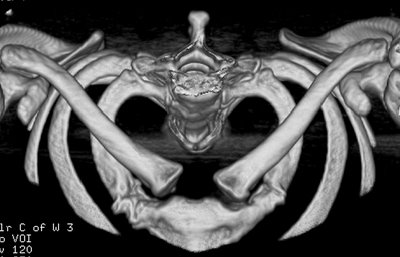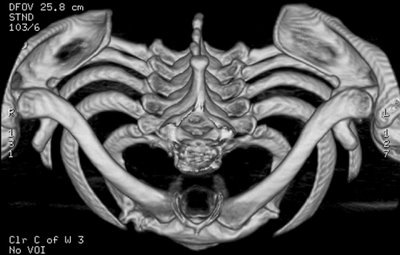Rides, ramblings and rants on a motorcycle.
7.12.2006,9:46 PM
I'm Inside Out!
I am fascinated with 'why' and 'how'. That is why I am a scientist. How do we tick? Why? I asked those questions when I was knee-high to a tree and I still do.
Modern biotechnology is wonderful. It reveals the wonders that we can't see without it. It tells us more about ourselves and about each other, all those living things that surround us. Ironically we can see inside our bodies but still scratch our heads on the outside wondering how we tick inside our brains.
A few years ago, while spending days [1] extracting DNA from large quantities of white blood cells from cows' blood, I added a small test tube of my own WBCs. I had room in the centrifuge; why not? The feeling of seeing thin threads of your own DNA floating in solution inside a gently rocking test tube is inexplicable. Those fine threads were a history catalog of generations before me, before my mother and father, before them. They were strings of time more ancient that any of us can fathom, carrying the instructions on what makes me human. And how similar yet different I am from each of you. Ironically, even similar to the thick ropes of cow DNA rocking alongside in their own test tubes.
A similar opportunity arose today.
It was with a childlike curiosity that I was shown the CT scans of my chest and shoulders today. I saw the twinkle in the orthopedic surgeon's eyes upon seeing my childlike curiosity and flood of questions. I followed him back to the radiology review room to see my scans on the computer. There on the monitors were 3-D images of my chest wall, front to spine, and shoulders. I laughed when the Doc mentioned that my head had to be 'cut off' of my spine for the images (the technician removes the scanned slices of my head during the computerized rendition).
What is a CT scan, you ask? Computed axial tomography (CAT or CT scan) is medical imaging technology by which a three-dimensional image of the inside of the body is generated from a large series of two-dimensional x-ray images taken around a single axis of rotation. Slices of images from the rotating ring are pieced together by digital geometry processing which renders the image in three dimensions and various planes of the body. In other words, it's a 3-D view inside you. A way to become intimate with yourself like never before.
While laying on the bench and inserted in the middle of the rotating tube, I was instructed by a recorded youthful but confident male voice:
"Take a deep breath. Hold your breath."
Holding. Waiting. Holding still. Waiting more. Wondering if this was as long as the laps I used to swim...... listening to the whirring of the machine.
Finally, "Breathe!"
Whew!
Thirty-six hours later, I'm looking at the digital 3-D images of the inside of my body: my bones. There's my spine without a head, the calcium deposit on the first right rib ("I bet that was from the car accident I had long ago!"), scapulas look normal, left clavicle looks normal.....Oh, what's this?
The end of the right clavicle that usually sits in a little pocket on the top of the sternum has jumped ship. It is pushed inwards (posterior) and up (superior). It's dislocated. That explained the pressure on my trachea earlier. Concerned, the Doc needed to know the degree of posterior displacement to guide a decision on how to treat the dislocation. The CT scan revealed that despite it's posterior placement, it is far enough away from the trachea and will not require surgery. The pressure experienced earlier was most likely the acute inflammation of the joint capsule and ligaments. In any joint dislocation, the connective tissue swells with fluid and blood, becoming inflamed and swollen all around the area. Pain and restricted movement are the most common symptoms, accompanying radial pain and swelling, even spasms, in nearby muscle tissue. Hence the tight upper traps and neck muscles on the right side.


Heat for the spasming muscles, ice for the inflammation in the sternoclavicular joint, anti-inflammatories and restricted activity. Avoid using the pec muscles and overhead arm movement; no bench presses and back workouts for awhile.
Doc was horrified when I reported that I ride a motorcycle to commute every day, and usually a long ride on the weekends. He replied "That's NOT going to help this!" So we negotiated: I promised I would ride the truck for a week but I am back on the bike by Saturday. No weight training at all for two weeks, and then no upper body training for at least 4-6 weeks. I'm going to have bulky strong legs by then.....
Knowing that I am a cell biologist on campus and detecting an enthusiasm for new techniques, Doc gave me a CD with my CT scans along with a copy of the viewing program (I can rotate them at any angle).
I returned to my lab and office with a new toy in tow.
[1] I collaborated with a colleague to develop a sensitive assay for detection of the tiny microscopic single-celled parasites (Trypanosomes) in the blood of cows that literally beat up blood (red and white) cells with their 'tails' (flagellum) and weaken their immune system. It entailed extracting DNA from the fraction of liters of blood containing the WBC; in that fraction were the parasites and their DNA. A close 'cousin' of the same 'critter' is guilty of causing Sleeping Sickness in humans.
Modern biotechnology is wonderful. It reveals the wonders that we can't see without it. It tells us more about ourselves and about each other, all those living things that surround us. Ironically we can see inside our bodies but still scratch our heads on the outside wondering how we tick inside our brains.
A few years ago, while spending days [1] extracting DNA from large quantities of white blood cells from cows' blood, I added a small test tube of my own WBCs. I had room in the centrifuge; why not? The feeling of seeing thin threads of your own DNA floating in solution inside a gently rocking test tube is inexplicable. Those fine threads were a history catalog of generations before me, before my mother and father, before them. They were strings of time more ancient that any of us can fathom, carrying the instructions on what makes me human. And how similar yet different I am from each of you. Ironically, even similar to the thick ropes of cow DNA rocking alongside in their own test tubes.
A similar opportunity arose today.
It was with a childlike curiosity that I was shown the CT scans of my chest and shoulders today. I saw the twinkle in the orthopedic surgeon's eyes upon seeing my childlike curiosity and flood of questions. I followed him back to the radiology review room to see my scans on the computer. There on the monitors were 3-D images of my chest wall, front to spine, and shoulders. I laughed when the Doc mentioned that my head had to be 'cut off' of my spine for the images (the technician removes the scanned slices of my head during the computerized rendition).
What is a CT scan, you ask? Computed axial tomography (CAT or CT scan) is medical imaging technology by which a three-dimensional image of the inside of the body is generated from a large series of two-dimensional x-ray images taken around a single axis of rotation. Slices of images from the rotating ring are pieced together by digital geometry processing which renders the image in three dimensions and various planes of the body. In other words, it's a 3-D view inside you. A way to become intimate with yourself like never before.
While laying on the bench and inserted in the middle of the rotating tube, I was instructed by a recorded youthful but confident male voice:
"Take a deep breath. Hold your breath."
Holding. Waiting. Holding still. Waiting more. Wondering if this was as long as the laps I used to swim...... listening to the whirring of the machine.
Finally, "Breathe!"
Whew!
Thirty-six hours later, I'm looking at the digital 3-D images of the inside of my body: my bones. There's my spine without a head, the calcium deposit on the first right rib ("I bet that was from the car accident I had long ago!"), scapulas look normal, left clavicle looks normal.....Oh, what's this?
The end of the right clavicle that usually sits in a little pocket on the top of the sternum has jumped ship. It is pushed inwards (posterior) and up (superior). It's dislocated. That explained the pressure on my trachea earlier. Concerned, the Doc needed to know the degree of posterior displacement to guide a decision on how to treat the dislocation. The CT scan revealed that despite it's posterior placement, it is far enough away from the trachea and will not require surgery. The pressure experienced earlier was most likely the acute inflammation of the joint capsule and ligaments. In any joint dislocation, the connective tissue swells with fluid and blood, becoming inflamed and swollen all around the area. Pain and restricted movement are the most common symptoms, accompanying radial pain and swelling, even spasms, in nearby muscle tissue. Hence the tight upper traps and neck muscles on the right side.


Heat for the spasming muscles, ice for the inflammation in the sternoclavicular joint, anti-inflammatories and restricted activity. Avoid using the pec muscles and overhead arm movement; no bench presses and back workouts for awhile.
Doc was horrified when I reported that I ride a motorcycle to commute every day, and usually a long ride on the weekends. He replied "That's NOT going to help this!" So we negotiated: I promised I would ride the truck for a week but I am back on the bike by Saturday. No weight training at all for two weeks, and then no upper body training for at least 4-6 weeks. I'm going to have bulky strong legs by then.....
Knowing that I am a cell biologist on campus and detecting an enthusiasm for new techniques, Doc gave me a CD with my CT scans along with a copy of the viewing program (I can rotate them at any angle).
I returned to my lab and office with a new toy in tow.
[1] I collaborated with a colleague to develop a sensitive assay for detection of the tiny microscopic single-celled parasites (Trypanosomes) in the blood of cows that literally beat up blood (red and white) cells with their 'tails' (flagellum) and weaken their immune system. It entailed extracting DNA from the fraction of liters of blood containing the WBC; in that fraction were the parasites and their DNA. A close 'cousin' of the same 'critter' is guilty of causing Sleeping Sickness in humans.

